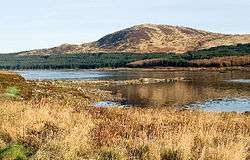Loch Doon
| Loch Doon | |
|---|---|
 | |
| Location | Carrick |
| Coordinates | 55°15′00″N 4°22′19″W / 55.250°N 4.372°WCoordinates: 55°15′00″N 4°22′19″W / 55.250°N 4.372°W |
| Type | freshwater loch |
| Primary outflows | River Doon |
| Basin countries | Scotland |
Loch Doon (Scottish Gaelic: Loch Dùin, pronounced [ɫ̪ɔxˈt̪uːɲ]) is a freshwater loch in Carrick, Scotland. The River Doon issues from its northern end, while the loch itself receives waters from Loch Enoch (in the Galloway Hills) via Eglin Lane.
In the 13th century, it was a site of Balloch Castle, owned by the Earls of Carrick. During the Scottish Wars of Independence it was held by one Gille Brighde, Sir Gilbert de Carrick, a native Carrick nobleman who surrendered it to the English. It was soon recovered by the Scots. In the 15th century, it was frequently in the hands of the Kennedy Clan, although it was briefly in the hands of the Maclellans (backed by William Douglas, 8th Earl of Douglas) after a siege in 1446. The castle was destroyed in the 16th century by King James V as part of a general policy of reducing the power of the barons.
During the First World War, there was a growing need to train pilots and aircrew in the art of aerial gunnery.
Loch Doon was thought to be ideally suited for such an establishment with its surrounding steep hills being an ideal position for target ranges. Work begin in September 1916 and an airfield, slipways, piers, jetties, seaplane hangars, tramways and other associated buildings erected. The remains of these can still be found on the Loch shore today.
The loch was dammed in the 1930s, raising the water some 27 feet, in order to provide seasonal storage for the Galloway hydro-electric power scheme. As a reservoir, Loch Doon has an effective capacity of over 82 million cubic metres. When rainfall is plentiful, water is diverted to the loch from the Water of Deugh via a tunnel system. When water is required for power generation, water is released at Drumjohn to feed Kendoon power reservoir, the first in a series of generating stations and reservoirs on the Water of Ken.
During the construction of the scheme, the ruins of the castle were moved from an island in the Loch to the shore to avoid the rising water.
During the Second World War, two aircraft are known to have crashed in the Loch or near to it.
Hawker Hurricane Mk.IV LD564 was on a routine training flight being flown by Flying Officer Roswell Murray MacTavish, 439 Squadron, Royal Canadian Air Force, from RAF Ayr, when it crashed into the forest beside Loch Doon. The pilot was killed and is buried in Ayr Cemetery. Remains of the aircraft, including its Rolls Royce Merlin engine, can still be found at the crash site.
The Loch Doon Spitfire
On 25 October 1941, Supermarine Spitfire Mk.IIA P7540 was on a routine training flight being flown by Flying Officer Frantisek Hekl, 312 (Czech) Squadron from RAF Ayr. The aircraft was seen flying low over Loch Doon, when one wingtip made contact with the surface of the Loch, cartwheeling the aircraft into the water. It was finally recovery from Loch Doon in 1982 by divers from the Dumfries and Galloway Sub Aqua Club assisted divers from the Blackpool Sub Aqua Club. Frantisek Hekl’s body was never found. The aircraft has been restored to static condition and is on display at the Dumfries and Galloway Aviation Museum where it was unveiled to the public in 2017.
See also
External links
| Wikimedia Commons has media related to Loch Doon. |
- Pictures of Loch Doon
- - Video footage of Loch Doon or Balliol Castle.
